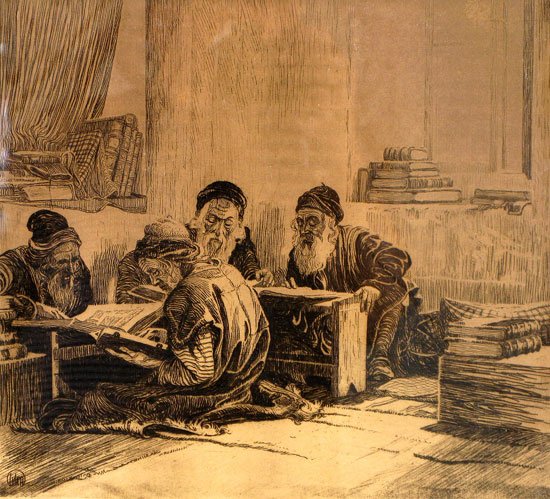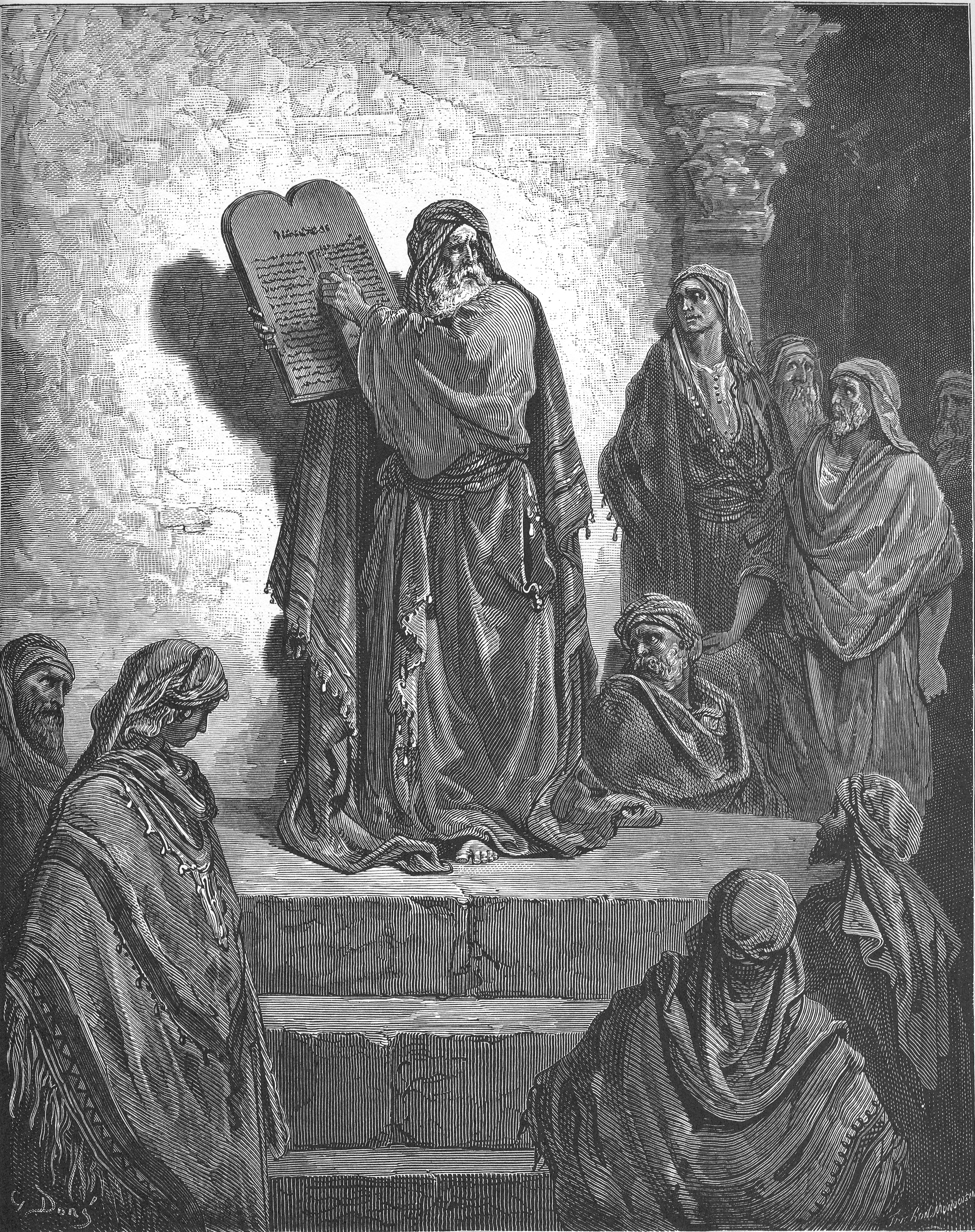|
Oral Torah
According to Rabbinic Judaism, the Oral Torah or Oral Law ( he, , Tōrā šebbəʿal-pe}) are those purported laws, statutes, and legal interpretations that were not recorded in the Five Books of Moses, the Written Torah ( he, , Tōrā šebbīḵṯāv, "Written Law", label=none), but nonetheless are regarded by Orthodox Jews as prescriptive and given at the same time. This holistic Jewish code of conduct encompasses a wide swathe of rituals, worship practices, Godman and interpersonal relationships, from dietary laws to Sabbath and festival observance to marital relations, agricultural practices, and civil claims and damages. According to Rabbinic Jewish tradition, the Oral Torah was passed down orally in an unbroken chain from generation to generation until its contents were finally committed to writing following the destruction of the Second Temple in 70 CE, when Jewish civilization was faced with an existential threat, by virtue of the dispersion of the Jewish people. The ma ... [...More Info...] [...Related Items...] OR: [Wikipedia] [Google] [Baidu] |
Rabbinic Judaism
Rabbinic Judaism ( he, יהדות רבנית, Yahadut Rabanit), also called Rabbinism, Rabbinicism, or Judaism espoused by the Rabbanites, has been the mainstream form of Judaism since the 6th century CE, after the codification of the Babylonian Talmud. Rabbinic Judaism has its roots in Pharisaic Judaism and is based on the belief that Moses at Mount Sinai received both the Written Torah (''Torah she-be-Khetav'') and the Oral Torah (''Torah she-be-al Peh'') from God. The Oral Torah, transmitted orally, explains the Written Torah. At first, it was forbidden to write down the Oral Torah because the rabbis feared that it would become rigid and lose its flexibility, but after the destruction of the Second Temple they decided to write it down in the Talmud and other rabbinic texts. Rabbinic Judaism contrasts with the Sadducees, Karaite Judaism and Samaritanism, which do not recognize the Oral Torah as a divine authority nor the rabbinic procedures used to interpret Jewish scripture. ... [...More Info...] [...Related Items...] OR: [Wikipedia] [Google] [Baidu] |
Jewish Principles Of Faith
There is no established formulation of principles of faith that are recognized by all branches of Judaism. Central authority in Judaism is not vested in any one person or group - although the Sanhedrin, the supreme Jewish religious court, would fulfill this role if it were re-established - but rather in Judaism's sacred writings, laws, and traditions. Judaism affirms the existence and uniqueness of God, and stresses performance of deeds or commandments alongside adherence to a strict belief system. In contrast to traditions such as Christianity which demand a more explicit identification of God, faith in Judaism requires one to honour God through a constant struggle with God's instructions (Torah) and the practice of their mitzvot. Orthodox Judaism stresses a number of core principles in its educational programs, most importantly a belief that there is one single, omniscient, transcendent, non-compound God, who created the universe, and continues to be concerned with its gov ... [...More Info...] [...Related Items...] OR: [Wikipedia] [Google] [Baidu] |
Ezra
Ezra (; he, עֶזְרָא, '; fl. 480–440 BCE), also called Ezra the Scribe (, ') and Ezra the Priest in the Book of Ezra, was a Jewish scribe (''sofer'') and priest (''kohen''). In Greco-Latin Ezra is called Esdras ( grc-gre, Ἔσδρας). According to the Hebrew Bible he was a descendant of Sraya, the last High Priest to serve in the First Temple, and a close relative of Joshua, the first High Priest of the Second Temple. He returned from Babylonian exile and reintroduced the Torah in Jerusalem. According to 1 Esdras, a Greek translation of the Book of Ezra still in use in Eastern Orthodoxy, he was also a High Priest. Rabbinic tradition holds that he was an ordinary member of the priesthood. Several traditions have developed over his place of burial. One tradition says that he is buried in al-Uzayr near Basra (Iraq), while another tradition alleges that he is buried in Tadif near Aleppo, in northern Syria. His name may be an abbreviation of ', " Yah helps". In the ... [...More Info...] [...Related Items...] OR: [Wikipedia] [Google] [Baidu] |
Tanakh
The Hebrew Bible or Tanakh (;"Tanach" ''''. : ''Tānāḵh''), also known in Hebrew as Miqra (; : ''Mīqrā''), is the canonical collection of script ... [...More Info...] [...Related Items...] OR: [Wikipedia] [Google] [Baidu] |
Law Given To Moses At Sinai
A law given to Moses at Sinai ( he, הלכה למשה מסיני, Halakhah le-Moshe mi-Sinai) refers to a halakhic law for which there is no biblical reference or source, but rather was passed down orally as a teaching originating from Moses at Sinai. Such teachings have not been derived from any Talmudical hermeneutics, but known solely from the Jewish tradition. Status According to Rabbinic Judaism, God transmitted the Torah to Moses in two parts: the ''written Torah'' which comprises the biblical books of Genesis through Deuteronomy, and the Oral Torah which was relayed orally, from Moses to his successors, to their successors, and finally to the rabbis. In rabbinic discourse, a "law given to Moses at Sinai" refers to a law which has no source in the written Torah, and thus must have been transmitted orally since the time of Moses. These laws are nonetheless considered by the Talmud to have the force and gravity of biblical law as if they are written explicitly in the Torah. ... [...More Info...] [...Related Items...] OR: [Wikipedia] [Google] [Baidu] |
Halakhot
''Halakha'' (; he, הֲלָכָה, ), also transliterated as ''halacha'', ''halakhah'', and ''halocho'' ( ), is the collective body of Jewish religious laws which is derived from the written and Oral Torah. Halakha is based on biblical commandments ('' mitzvot''), subsequent Talmudic and rabbinic laws, and the customs and traditions which were compiled in the many books such as the ''Shulchan Aruch''. ''Halakha'' is often translated as "Jewish law", although a more literal translation of it might be "the way to behave" or "the way of walking". The word is derived from the root which means "to behave" (also "to go" or "to walk"). ''Halakha'' not only guides religious practices and beliefs, it also guides numerous aspects of day-to-day life. Historically, in the Jewish diaspora, ''halakha'' served many Jewish communities as an enforceable avenue of law – both civil and religious, since no differentiation of them exists in classical Judaism. Since the Jewish Enlightenment (''Hask ... [...More Info...] [...Related Items...] OR: [Wikipedia] [Google] [Baidu] |
Midrash
''Midrash'' (;"midrash" ''Random House Webster's Unabridged Dictionary''. he, מִדְרָשׁ; or מִדְרָשׁוֹת ''midrashot'') is expansive using a rabbinic mode of interpretation prominent in the . The word itself means "textual interpretation", "study", or " |
Tosefta
The Tosefta (Jewish Babylonian Aramaic: תוספתא "supplement, addition") is a compilation of the Jewish oral law from the late 2nd century, the period of the Mishnah. Overview In many ways, the Tosefta acts as a supplement to the Mishnah (''tosefta'' means "supplement, addition"). The Mishnah ( he, משנה) is the basic compilation of the Oral law of Judaism; according to the tradition, it was compiled in 189 CE. The Tosefta closely corresponds to the Mishnah, with the same divisions for ''sedarim'' ("orders") and ''masekhtot'' ("tractates"). It is mainly written in Mishnaic Hebrew, with some Aramaic. At times the text of the Tosefta agrees nearly verbatim with the Mishnah. At others there are significant differences. The Tosefta often attributes laws that are anonymous in the Mishnah to named Tannaim. It also augments the Mishnah with additional glosses and discussions. It offers additional aggadic and midrashic material, and it sometimes contradicts the Mishnah in the ru ... [...More Info...] [...Related Items...] OR: [Wikipedia] [Google] [Baidu] |
Jewish Encyclopedia
''The Jewish Encyclopedia: A Descriptive Record of the History, Religion, Literature, and Customs of the Jewish People from the Earliest Times to the Present Day'' is an English-language encyclopedia containing over 15,000 articles on the history, culture, and state of Judaism up to the early 20th century. The encyclopedia's managing editor was Isidore Singer and the editorial board was chaired by Isaac K. Funk and Frank H. Vizetelly. The work's scholarship is still highly regarded. The American Jewish Archives deemed it "the most monumental Jewish scientific work of modern times", and Rabbi Joshua L. Segal said "for events prior to 1900, it is considered to offer a level of scholarship superior to either of the more recent Jewish encyclopedias written in English." It was originally published in 12 volumes between 1901 and 1906 by Funk & Wagnalls of New York, and reprinted in the 1960s by KTAV Publishing House. It is now in the public domain. History Concep ... [...More Info...] [...Related Items...] OR: [Wikipedia] [Google] [Baidu] |
Haymanot
Haymanot ( gez, ሃይማኖት) is the branch of Judaism which is practiced by the Beta Israel, also known as Ethiopian Jews. In Geʽez, Tigrinya and Amharic, ''Haymanot'' means 'religion' or 'faith.' Thus in modern Amharic and Tigrinya, it is common to speak of the Christian ''haymanot'', the Jewish ''haymanot'' or the Muslim ''haymanot''. In Israel, the term is only associated with a particular religion (Judaism). Religious leaders *''Nabiyy'' (Prophet), related to the Arabic and Hebrew words ''nabī'' and ''nevi'', used in Jewish and Islamic writing to refer to prophets. *''Monkosa'' (Monk), related to the Greek word ''monakhós'', which means "alone, solitary." *''Kahen'' or ''Kes'' (Priest), spiritual leader, similar to a Kohen and analogous to a Rabbi or ''Hakham''. *'' Liqa Kahnet'', (High Priest) *''Debtera'', itinerant holy man *'' Shmagle'', elder Texts ''Mäṣḥafä Kedus'' (Holy Scriptures) is the name for the religious literature. The language of the writings i ... [...More Info...] [...Related Items...] OR: [Wikipedia] [Google] [Baidu] |
Beta Israel
The Beta Israel ( he, בֵּיתֶא יִשְׂרָאֵל, ''Bēteʾ Yīsrāʾēl''; gez, ቤተ እስራኤል, , modern ''Bēte 'Isrā'ēl'', EAE: "Betä Ǝsraʾel", "House of Israel" or "Community of Israel"), also known as Ethiopian Jews ( he, יְהוּדֵי אֶתְיוֹפְּיָה: ''Yehudey Etyopyah;'' Ge'ez: የኢትዮጵያ አይሁድዊ, ''ye-Ityoppya Ayhudi''), are a Jewish community that developed and lived for centuries in the area of the Kingdom of Aksum and the Ethiopian Empire, which is currently divided between the modern-day Amhara and Tigray regions of Ethiopia. Most of the Beta Israel community immigrated to Israel in the late 20th century. The Beta Israel lived in northern and northwestern Ethiopia, in more than 500 small villages which were spread over a wide territory, alongside populations that were Muslim and predominantly Christian. Most of them were concentrated mainly on what are today North Gondar Zone, Shire Inda Selassie, Wolqayit, T ... [...More Info...] [...Related Items...] OR: [Wikipedia] [Google] [Baidu] |
Karaite Judaism
Karaite Judaism () or Karaism (, sometimes spelt Karaitism (; ''Yahadut Qara'it''); also spelt Qaraite Judaism, Qaraism or Qaraitism) is a Jewish religious movement characterized by the recognition of the written Torah alone as its supreme authority in ''halakha'' (Jewish religious law) and theology. Karaites believe that all of the divine commandments which were handed down to Moses by God were recorded in the written Torah without any additional Oral Law or explanation. Unlike mainstream Rabbinic Judaism, which considers the Oral Torah, codified in the Talmud and subsequent works, to be authoritative interpretations of the Torah, Karaite Jews do not believe that the written collections of the oral tradition in the Midrash or the Talmud are binding. When they read the Torah, Karaites strive to adhere to the plain or most obvious meaning (''peshat'') of the text; this is not necessarily the literal meaning of the text, instead, it is the meaning of the text that would have be ... [...More Info...] [...Related Items...] OR: [Wikipedia] [Google] [Baidu] |




.jpg)

_Takuyo.jpg)
